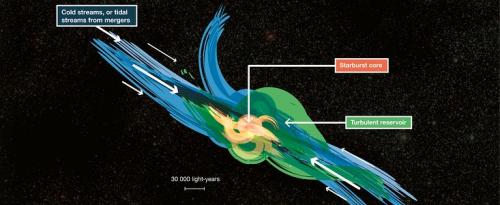ALMA Finds Huge Hidden Reservoirs of Turbulent Gas in Distant Galaxies
First detection of CH+ molecules in distant starburst galaxies provides insight into star formation history of the Universe
A team led by Edith Falgarone (Ecole Normale Supérieure and Observatoire de Paris, France) has used the Atacama Large Millimeter/submillimeter Array (ALMA) to detect signatures of the carbon hydride molecule CH+ in distant starburst galaxies. The group identified strong signals of CH+ in five out of the six galaxies studied, including the Cosmic Eyelash (eso1012). This research provides new information that helps astronomers understand the growth of galaxies and how a galaxy’s surroundings fuel star formation.

ALMA has been used to detect turbulent reservoirs of cold gas surrounding distant starburst galaxies. By detecting CH+ for the first time in the distant Universe this research opens up a new window of exploration into a critical epoch of star formation. The presence of this molecule sheds new light on how galaxies manage to extend their period of rapid star formation.
“CH+ is a special molecule. It needs a lot of energy to form and is very reactive, which means its lifetime is very short and it can’t be transported far. CH+ therefore traces how energy flows in the galaxies and their surroundings,” said Martin Zwaan, an astronomer at ESO, who contributed to the paper.
How CH+ traces energy can be thought of by analogy to being on a boat in a tropical ocean on a dark, moonless night. When the conditions are right, fluorescent plankton can light up around the boat as it sails. The turbulence caused by the boat sliding through the water excites the plankton to emit light, which reveals the existence of the the turbulent regions in the underlying dark water. Since CH+ forms exclusively in small areas where turbulent motions of gas dissipates, its detection in essence traces energy on a galactic scale.
The observed CH+ reveals dense shock waves, powered by hot, fast galactic winds originating inside the galaxies’ star forming regions. These winds flow through a galaxy, and push material out of it, but their turbulent motions are such that part of the material can be re-captured by the gravitational pull of the galaxy itself. This material gathers into huge turbulent reservoirs of cool, low-density gas, extending more than 30 000 light-years from the galaxy’s star forming region.
“With CH+, we learn that energy is stored within vast galaxy-sized winds and ends up as turbulent motions in previously unseen reservoirs of cold gas surrounding the galaxy,” said Falgarone, who is lead author of the new paper. “Our results challenge the theory of galaxy evolution. By driving turbulence in the reservoirs, these galactic winds extend the starburst phase instead of quenching it.”
The team determined that galactic winds alone could not replenish the newly revealed gaseous reservoirs and suggests that the mass is provided by galactic mergers or accretion from hidden streams of gas, as predicted by current theory.
“This discovery represents a major step forward in our understanding of how the inflow of material is regulated around the most intense starburst galaxies in the early Universe,” says ESO’s Director for Science, Rob Ivison, a co-author on the paper. “It shows what can be achieved when scientists from a variety of disciplines come together to exploit the capabilities of the world's most powerful telescope.”
Source: European Southern Observatory
- 430 reads
Human Rights
Fostering a More Humane World: The 28th Eurasian Economic Summi

Conscience, Hope, and Action: Keys to Global Peace and Sustainability

Ringing FOWPAL’s Peace Bell for the World:Nobel Peace Prize Laureates’ Visions and Actions

Protecting the World’s Cultural Diversity for a Sustainable Future

Puppet Show I International Friendship Day 2020

